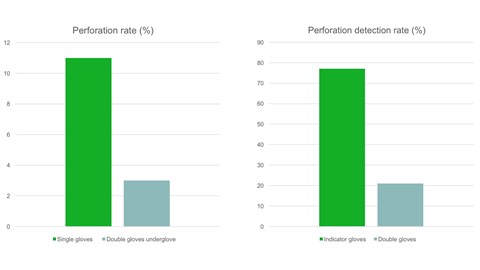Cochrane reviews on double-gloving
The efficacy of double-gloving to reduce the risk of an inner-glove perforation and increase the detection of perforations when they occurred has been evaluated in two different Cochrane systematic reviews

Objectives
The two Cochrane reviews assessed different aspects of double-gloving and aimed to:
• assess whether additional glove protection reduces the number of underglove perforations
• determine whether there is a clinically significant difference in using extra gloves for preventing needlestick injuries during surgery as well as to evaluate whether double gloving has a negative impact on the healthcare professional's hand skills (dexterity)
Methodology
- Tanner et al, 2006, compared single-gloving, double-gloving and coloured puncture-indicating systems and included thirty-one randomized controlled trials measuring glove perforations
. - The review from 2014, included thirty-four randomized controlled trials measuring glove perforations. Increasing numbers of glove layers (single, double, triple) were evaluated
. - This review also included four additional gloving methods (glove liner, cloth overgloves, steel-weave overgloves and triple gloves)
. - Risk was determined through the measurement of perforations and self-reported needlestick injuries. Dexterity was measured via self-reporting and perforation rate
.

Results
Ten studies in the Tanner review could be systematically reviewed for perforation rates in single versus double-gloving and demonstrated double-gloving was significantly more efficient in preventing perforations in the inner glove: 11 percent of single gloves perforated; 3 percent of undergloves perforated with double-gloving.
Significantly more punctures were detected with Biogel Puncture Indication System gloves.
Mischke et al also demonstrated that double-gloving significantly reduced the risk for innerglove perforation.
The evidence from these two systematic reviews confirms that double-gloving provides better protection against blood contamination and inner glove perforations.
Related products
'References'











